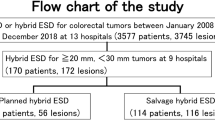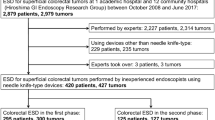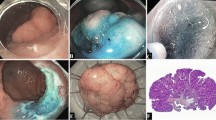Abstract
Background
Endoscopic submucosal dissection (ESD) with snaring (hybrid ESD) bridges the gap between ESD and endoscopic mucosal resection. We evaluated factors predictive of en bloc and complete resection of large colorectal neoplasms using hybrid ESD.
Methods
This was a prospective clinical study of 78 patients who underwent hybrid ESD for excision of colorectal neoplasms (≥ 2 cm) between May 2015 and September 2016 at six university hospitals. We evaluated lesion and patient characteristics, endoscopist experience level (< 50 or ≥ 50 cases with colorectal ESD), and technical factors such as concurrent fibrosis, completion of a circumferential incision, degree of submucosal dissection (< 50 or ≥ 50%), and visualization during snaring (< 50 or ≥ 50%).
Results
Multivariate analyses showed that the en bloc resection rate was significantly related to the degree of visualization during snaring (odds ratio (OR) 7.811, 95% confidence interval [CI] 1.722–35.426; p = 0.008) and the presence of fibrosis (OR 0.258, 95% CI 0.68–0.993; p = 0.049). The complete resection rate was significantly related to the colorectal ESD endoscopist skill level (OR 5.626, 95% CI 1.485–21.313; p = 0.011) and gross lesion type (OR 0.145, 95% CI 0.022–0.936; p = 0.042). When all three technical factors, i.e., completion of circumferential incision, ≥ 50% submucosal dissection, and ≥ 50% visualization during snaring, were satisfied performing hybrid ESD, the en bloc resection rate (87.5%) was similar to that of ESD.
Conclusions
Visualization during snaring, presence of fibrosis, gross lesion type, and endoscopist colorectal ESD experience level affect en bloc or complete resection of large colorectal neoplasia using hybrid ESD.


Similar content being viewed by others
Change history
17 July 2018
The original version of the article unfortunately contained errors in author affiliation. Affiliation of third and ninth author was incorrectly assigned.
References
Conio M, Repici A, Demarquay JF, Blanchi S, Dumas R, Filiberti R. EMR of large sessile colorectal polyps. Gastrointest Endosc. 2004;60:234–241.
Inoue H, Takeshita K, Hori H, Muraoka Y, Yoneshima H, Endo M. Endoscopic mucosal resection with a cap-fitted panendoscope for esophagus, stomach, and colon mucosal lesions. Gastrointest Endosc. 1993;39:58–62.
Suzuki Y, Hiraishi H, Kanke K, et al. Treatment of gastric tumors by endoscopic mucosal resection with a ligating device. Gastrointest Endosc. 1999;49:192–199.
Moss A, Bourke MJ, Tran K, et al. Lesion isolation by circumferential submucosal incision prior to endoscopic mucosal resection (CSI-EMR) substantially improves en bloc resection rates for 40-mm colonic lesions. Endoscopy. 2010;42:400–404.
Lee EJ, Lee JB, Lee SH, Youk EG. Endoscopic treatment of large colorectal tumors: comparison of endoscopic mucosal resection, endoscopic mucosal resection-precutting, and endoscopic submucosal dissection. Surg Endosc. 2012;26:2220–2230.
Akintoye E, Kumar N, Aihara H, Nas H, Thompson CC. Colorectal endoscopic submucosal dissection: a systematic review and meta-analysis. Endosc Int Open. 2016;4:E1030–E1044.
Fuccio L, Hassan C, Ponchon T, et al. Clinical outcomes after endoscopic submucosal dissection for colorectal neoplasia: a systematic review and meta-analysis. Gastrointest Endosc. 2017;86:74–86e17.
Niimi K, Fujishiro M, Kodashima S, et al. Long-term outcomes of endoscopic submucosal dissection for colorectal epithelial neoplasms. Endoscopy. 2010;42:723–729.
Byeon JS, Yang DH, Kim KJ, et al. Endoscopic submucosal dissection with or without snaring for colorectal neoplasms. Gastrointest Endosc. 2011;74:1075–1083.
Saito Y, Fukuzawa M, Matsuda T, et al. Clinical outcome of endoscopic submucosal dissection versus endoscopic mucosal resection of large colorectal tumors as determined by curative resection. Surg Endosc. 2010;24:343–352.
Bae JH, Yang DH, Lee S, et al. Optimized hybrid endoscopic submucosal dissection for colorectal tumors: a randomized controlled trial. Gastrointest Endosc. 2016;83:584–592.
Toyonaga T, Man IM, Morita Y, Azuma T. Endoscopic submucosal dissection (ESD) versus simplified/hybrid ESD. Gastrointest Endosc Clin N Am. 2014;24:191–199.
Matsumoto A, Tanaka S, Oba S, et al. Outcome of endoscopic submucosal dissection for colorectal tumors accompanied by fibrosis. Scand J Gastroenterol. 2010;45:1329–1337.
Jeon HH, Lee HS, Youn YH, Park JJ, Park H. Learning curve analysis of colorectal endoscopic submucosal dissection (ESD) for laterally spreading tumors by endoscopists experienced in gastric ESD. Surg Endosc. 2016;30:2422–2430.
Belderbos TD, Leenders M, Moons LM, Siersema PD. Local recurrence after endoscopic mucosal resection of nonpedunculated colorectal lesions: systematic review and meta-analysis. Endoscopy. 2014;46:388–402.
Hosokawa K, Yoshida S. Recent advances in endoscopic mucosal resection for early gastric cancer. Gan To Kagaku Ryoho. 1998;25:476–483.
Gotoda T, Kondo H, Ono H, et al. A new endoscopic mucosal resection procedure using an insulation-tipped electrosurgical knife for rectal flat lesions: report of two cases. Gastrointest Endosc. 1999;50:560–563.
Yamamoto H. Endoscopic submucosal dissection for colorectal tumors. Front Gastrointest Res. 2010;27:287–295.
Chiba H, Tachikawa J, Kurihara D, et al. Safety and efficacy of simultaneous colorectal ESD for large synchronous colorectal lesions. Endosc Int Open. 2017;5:E595–E602.
Yoshida N, Naito Y, Murakami T, et al. Tips for safety in endoscopic submucosal dissection for colorectal tumors. Ann Transl Med. 2017;5:185.
Kim EK, Han DS, Ro Y, Eun CS, Yoo KS, Oh YH. The submucosal fibrosis: what does it mean for colorectal endoscopic submucosal dissection? Intest Res. 2016;14:358–364.
Acknowledgments
This work was supported by a Soonchunhyang University Research Fund.
Author information
Authors and Affiliations
Corresponding author
Ethics declarations
Conflicts of interest
The authors declare they have no competing interests.
Rights and permissions
About this article
Cite this article
Jung, Y., Kim, J.W., Byeon, JS. et al. Factors Predictive of Complete Excision of Large Colorectal Neoplasia Using Hybrid Endoscopic Submucosal Dissection: A KASID Multicenter Study. Dig Dis Sci 63, 2773–2779 (2018). https://doi.org/10.1007/s10620-018-5140-2
Received:
Accepted:
Published:
Issue Date:
DOI: https://doi.org/10.1007/s10620-018-5140-2




